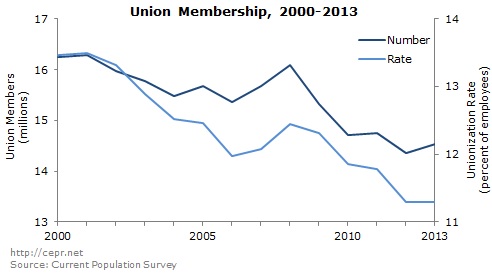Union Membership Is Declining Less in Right to Work States
As even casual observers of U.S. labor policy know, union membership in the U.S. has been declining for a long time, both in absolute terms and as a percentage of the workforce.
Is union membership falling more precipitously in Right to Work states, where employees are legally protected from being fired for refusal to join or pay dues or fees to an unwanted union, than in states where union financial support is frequently compulsory? Â Regardless of how you look at the numbers, it seems the answer is “No.”
Total union membership (including private- and public-sector workers combined) fell far less from 2003-2013 in the 22 states that had Right to Work laws on the books for the whole decade than in the 26 states that still lack such laws. Â (Since Indiana and Michigan only recently prohibited compulsory union dues and fees, they are excluded from the following discussion.)
Over the last 10 years, union membership in Right to Work states fell by 2.0%, from 2.91 million to 2.85 million. Â Meanwhile, union membership in forced-unionism states dropped by 7.1%, from 11.58 million to 10.76 million. The percentage decline in forced-unionism states was 3.5 times as great. Â The share of all U.S. union members living in Right to Work states rose from 20.1% to 20.9%.
The more rapid union membership decline in forced-unionism states is largely a product of much slower growth in the overall workforce. But not entirely, it seems. Â As a share of the total workforce, union membership in Right to Work states fell from 6.3% to 5.5% over the past decade. That’s a 0.8 percentage point decline But union membership in forced-unionism states fell by 1.6 percentage points, from 16.8% to 15.2%.
The purpose of Right to Work laws is neither to help nor to hurt unions, but rather to empower workers either to make mediocre or bad unions better, or to cut off their financial support. Â Right to Work advocates believe they are vindicated regardless of whether employee freedom leads to union reform or membership losses for unresponsive, ineffective or detrimental unions.
Labor-policy analysts such as Mike Maciag (see the article linked below) have noticed that forced-unionism states saw the steepest drops in union membership in recent years, but most seem reluctant to draw the obvious conclusion: Â Whatever’s ailing unions in today’s America, compulsion certainly isn’t the answer.

In the 26 states that lacked Right to Work laws for the entire period, unions suffered a 2003-2013 percentage membership decline 3.5 times as great as the aggregate decline for states that had Right to Work laws on the books for the whole time. Image: cepr.net

